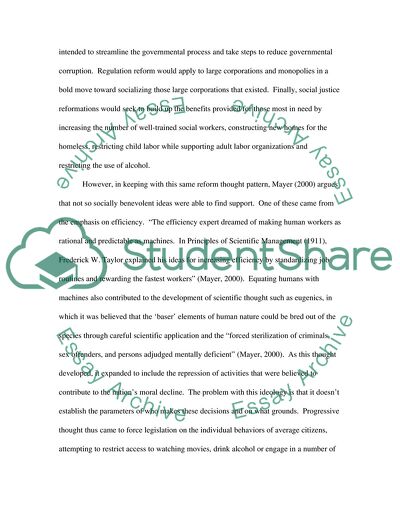
- Home
- Free Samples
- Premium Essays
- Editing Services
- Extra Tools
- Essay Writing Help
- About Us
- Studentshare
- Subjects
- Miscellaneous
- History
History - Essay Example

- Subject: Miscellaneous
- Type: Essay
- Level: Masters
- Pages: 4 (1000 words)
- Downloads: 0
- Author: daynebode
Extract of sample "History"
ellectual superiority, an exaggerated confidence in the social applications of science, an uncritical acceptance of the use of state power to coerce individual behavior, that all too readily could turn repressive and destructive” (Mayer, 2000). It is necessary to understand what is meant when one speaks of progressive social thought before it becomes possible to determine whether or not statements such as these have merit. According to Tallant (2001), Progressivism was focused on reformation in four key areas of government including democracy, efficiency, regulation and social justice.
Democracy could be improved by installing several features in government that would make the government more open to the general populace. Efficiency reformations were intended to streamline the governmental process and take steps to reduce governmental corruption. Regulation reform would apply to large corporations and monopolies in a bold move toward socializing those large corporations that existed. Finally, social justice reformations would seek to build up the benefits provided for those most in need by increasing the number of well-trained social workers, constructing new homes for the homeless, restricting child labor while supporting adult labor organizations and restricting the use of alcohol.
However, in keeping with this same reform thought pattern, Mayer (2000) argues that not so socially benevolent ideas were able to find support. One of these came from the emphasis on efficiency. “The efficiency expert dreamed of making human workers as rational and predictable as machines. In Principles of Scientific Management (1911), Frederick W. Taylor explained his ideas for increasing efficiency by standardizing job routines and rewarding the fastest workers” (Mayer, 2000). Equating humans with machines also contributed to the development of scientific thought such as eugenics, in which it was believed that the ‘baser’ elements of human nature could be bred
...Download file to see next pages Read MoreCHECK THESE SAMPLES OF History
History - United States History 1865
Patients History
Latin American history (Chicano history)
Aboriginal history
Colonial history US History
World history and american history
World history and american history
Native American History: Shawnee History

- TERMS & CONDITIONS
- PRIVACY POLICY
- COOKIES POLICY